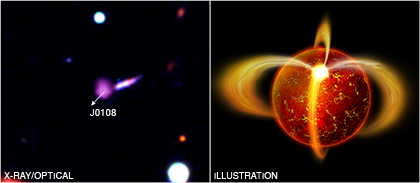Meet An Astronomer: Peter Edmonds
In the next installation of our new "Meet an Astronomer" series here on the Chandra blog, we introduce you to Dr. Peter Edmonds. Peter has been a part of our Education and Public Outreach group since 2003 and he has been an invaluable member of our team ever since. He helps find, track and develop the Chandra stories that we publicize, and he's instrumental in striking the right balance between scientific detail and public understanding.
Geriatric Pulsar Still Kicking
The composite image on the left shows an image from NASA's Chandra X-ray Observatory in purple and an optical image from the European Southern Observatory's Very Large Telescope (VLT) in red, blue and white. The Chandra source in the center of the image is the ancient pulsar PSR J0108-1431 (J0108 for short), located only 770 light years from us. The elongated object immediately to its upper right is a background galaxy that is unrelated to the pulsar. Since J0108 is located a long way from the plane of our galaxy, many distant galaxies are visible in the larger-scale optical image.
Announcing the 2009 Einstein Fellows
NASA announced today the selection of its 2009 Fellows, who are scientists who were recently (that is, since Jan. 1, 2006) awarded PhDs in astronomy, physics, or a related field. These new fellows can do research at any host institution in the US that they choose, and they represent some of the best and brightest in the field.
A New View of Tycho's Supernova Remnant
This composite image of the Tycho supernova remnant combines X-ray and infrared observations obtained with NASA's Chandra X-ray Observatory and Spitzer Space Telescope, respectively, and the Calar Alto observatory, Spain. It shows the scene more than four centuries after the brilliant star explosion witnessed by Tycho Brahe and other astronomers of that era.
Video Blog: Meet an Astronomer
A few weeks ago, we told you that Chandra was going to start introducing video into our blog. We've done some minor dabbling so far, but now we're stepping it up a bit. Today we are posting our first attempt at what we're calling (at the moment) "Meet an Astronomer." The idea is to do a quick interview with a scientist to give a small peek into their world. Let's face it, scientists - and science itself - can seem a little off-putting. This hopefully will make both of those feel a little more accessible and personal.
Where Does the "Harvard" Come From?
As most of you probably know, Chandra is a NASA mission. But, like with children, it sometimes takes a village to raise a mission. In Chandra's case, not only did it take many individuals to make it a success, it has required many institutions and organizations as well. (For a more comprehensive list, see https://www.chandra.harvard.edu/about/axaf_mission.html) But one frequent question we get is: why do you have "Harvard" in your website's name?
Black Hole Outflows From Centaurus A
This image of Centaurus A shows a spectacular new view of a supermassive black hole's power. Jets and lobes powered by the central black hole in this nearby galaxy are shown by submillimeter data (colored orange) from the Atacama Pathfinder Experiment (APEX) telescope in Chile and X-ray data (colored blue) from the Chandra X-ray Observatory. Visible light data from the Wide Field Imager on the Max-Planck/ESO 2.2 m telescope, also located in Chile, shows the dust lane in the galaxy and background stars.
New Chandra Images Added to Flickr
Enjoy new Chandra images recently added to the Flickr Commons SI photostream.
Wall Divides East and West Sides of Cosmic Metropolis
A new study unveils NGC 604, the largest region of star formation in the nearby galaxy M33, in its first deep, high-resolution view in X-rays. This composite image from Chandra X-ray Observatory data (colored blue), combined with optical light data from the Hubble Space Telescope (red and green), shows a divided neighborhood where some 200 hot, young, massive stars reside.
Chandra and Chandrayaan
We keep an eye out for all things astronomical in the news - especially when the words "Chandra" or "X-ray" pop up. Over the weekend, we noticed a story about both of these things, but this time it had nothing to do with us! [First image of moon's Haworth crater] The result was from an Indian spacecraft in orbit around the Moon that sent back some X-ray data of the surface.


